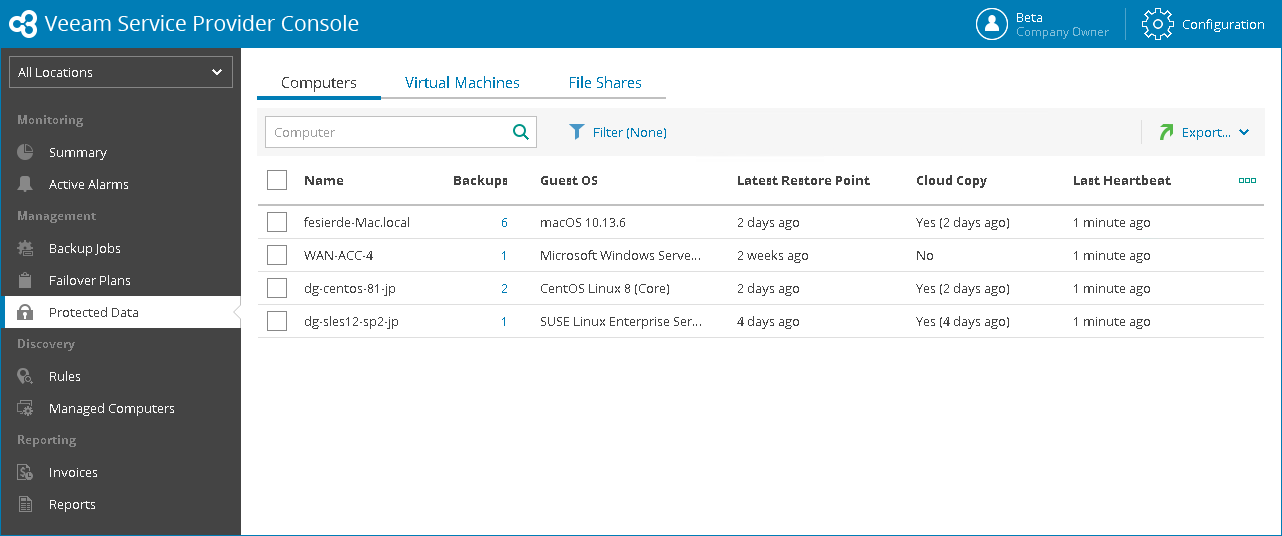 This is an archive version of the document. To get the most up-to-date information, see the current version.
This is an archive version of the document. To get the most up-to-date information, see the current version.Viewing and Exporting Protected Computer Details
You can view details of computers protected with Veeam backup agents and export them to a CSV or XML file.
Required Privileges
To perform this task, a user must have one of the following roles assigned: Company Owner, Company Administrator, Location Administrator, Location User, Subtenant.
Viewing and Exporting Protected Computer Details
To view and export details of Veeam backup agents protected by Veeam Backup & Replication:
- Log in to Veeam Service Provider Console.
For details, see Accessing Veeam Service Provider Console.
- In the menu on the left, click Protected Data.
- [For all roles except for Subtenant] Open the Computers tab.
Veeam Service Provider Console will display a list of all managed Veeam backup agents.
- To narrow down the list of computers, you can apply the following filters:
- Computer — search the list of computers by the name.
- Operation mode — limit the list of computers by Veeam backup agent operation mode (Server, Workstation).
- Cloud copy — limit the list of computers by cloud copy existence (Yes, No).
- Management mode — limit the list of computers by Veeam backup agent management mode (Managed by console, Managed by backup server).
To view details only for Veeam backup agents managed by Veeam Backup & Replication, select the Managed by backup server option.
- Backup type — limit the list of computers by backup operation type (Entire computer, Volume level, File level).
- Guest OS — limit the list of protected computers by guest OS (Windows, Linux, macOS).
- Location — limit the list of jobs by location to which jobs belong. To limit the list of jobs by location, use filter at the top left corner of the Veeam Service Provider Console window.
- To export protected computer details, click Export to and choose a format of the exported data:
- CSV — choose this option to structure exported data as a CSV file.
- XML — choose this option to structure exported data as an XML file.
The file with exported data will be saved to the default download location on your computer.
Each protected computer in the list is described with a set of properties. By default, some properties in the list are hidden. To display additional properties, click the ellipsis on the right of the list header and choose properties that must be displayed.
- Name — name of a protected computer.
- Tag — custom tag assigned to a computer.
- Backups — number of backup jobs configured for a computer.
You can click this property, to view and export backup job details. For details, see Veeam Backup Agent Job Details.
- Backup Copies — number of backup copy jobs configured for a computer.
You can click this property, to view and export backup copy job details. For details, see Veeam Backup Agent Job Details.
- Guest OS — type of computer operation system (Linux, Windows, macOS).
- Latest Restore Point — amount of time since the latest restore point was created for a protected computer.
- Cloud Copy — indicates if the cloud copy exists for a protected computer.
- Site — name of the Veeam Cloud Connect site on which the company is registered.
- Location — name of a location to which a monitored computer belongs.
- Last Heartbeat — amount of time since a management agent on a managed computer sent the latest heartbeat to Veeam Service Provider Console.
- Management Mode — Veeam backup agent management mode (Managed by console, Managed by backup server).
- Operation Mode — Veeam backup agent operation mode (Workstation, Server).
Veeam Backup Agent Job Details
You can view and export the following details on Veeam backup agent jobs:
- Job Name — name of a data protection job.
- (For backup jobs) Operation Mode — Veeam backup agent job operation mode (Server, Workstation).
- (For backup jobs) Backup Type — backup operation type (Entire computer, Volume level, File level).
- Restore Points — number of restore points available in the backup chain for a computer.
You can click this property to view details of each restore point. For details, see Restore Point Details.
- Latest Restore Point — amount of time since the latest restore point was created for a protected computer.
- Backup Size — total size of all restore points created by a job.
- Destination — target backup location.
- Next Job Run — date and time when the next job session will start.
You can view the following details on backed up data:
- Backed Up Items — type of backed up objects.
- Date — date of restore point creation.
- Source Size — size of the source data backed up.
- Backed Up Data — size of the data included in the backup increment.
- Restore Point Size — size of the restore point.
You can export restore points details. To do this, click Export to and choose a format of the exported data:
- CSV — choose this option to structure exported data as a CSV file.
- XML — choose this option to structure exported data as an XML file.
The file with exported data will be saved to the default download location on your computer.
